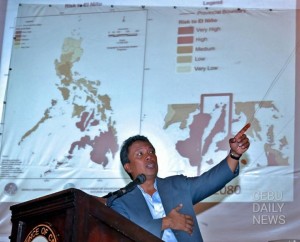State of calamity for 31 upland barangays

Secretary Nereus Acosta, Presidential Adviser on Environmental Protection shows a Philippine map where Cebu is one of the 12 areas where El Nino will continue or intensify. He spoke at the 1st Cebu Provincial Water Summit in the Capitol Social Hall. (CDN PHOTO/ JUNJIE MENDOZA)
The Cebu City Council yesterday declared 31 upland barangays under a state of calamity because of the effects of the dry spell.
This will enable the city to tap disaster funds for relief operations in areas which need it, said Councilor Gerry Carillo.
For now, he said, the city can use firetrucks to bring water supply to affected barangays.
“Let us use what we have,” he said.
The areas are upland barangays of Adlaon, Agsungot, Bacayan, Binaliw, Budlaan, Busay, Cambinocot, Guba, Lusaran, Mabini, Malubog, Paril, Pit-os, Pulangbato, Talamban, Taptap, Sirao, Kalunasan, Buhisan, Sapangdaku, Bonbon, Babag, Sudlon 1, Sudlon 2, Toong, Sinsin, Tabunan, Pung-ol Sibugay, Buot, Tagbao and Pamutan.
Members of the Hillyland Commission, farmers’ associations and barangay captains of the affected barangays will meet this week to identify action plans.
Councilor Nida Cabrera asked barangay officials to submit a list of their water sources.
“We were already informed by the weather agency before about what will happen when El Niñno comes. We need a-long term solution,” said Councilor Alvin Dizon.
The City Council action followed a day after an El Niño Water Summit was held by Cebu province the Capitol, where Mactan weather forecasters said the dry spell would last until August at the earliest or January next year at the latest.
Cebu is one of10 areas in the country where the El Niño-related dry spell will “continue or intensify”.
Presidential Advisor for Environmental Protection Neric Acosta said Cebu was one of the highest risk areas and among the most vulnerable to the dry spell.
“Cebu is one of the most ill-prepared for climate change. Cebu is critical because it is the fastest-growing region. The demand for water in Cebu is higher than the demand in Mindanao,” said Acosta.
Aside from reduced surface water, Cebu is threatened by rapid salt water intrusion which is linked to overextraction of ground water.
Initial feedback from 33 out of 50 towns showed that portions of farm lands, creeks and small lakes were drying up.
Whether this was a seasonal change that occurs during summer, or something that would continue to an alarming degree still has to be verified.
Cebu City agriculturist Joel Baclayon was also asked to assess the needs of mountain barangays where the dry spell is affective agriculture communities.
Anticipating the effects of the El Niño, the Cebu City Council last year already set aside P11 million to buy agriculture inputs charged to the city’s Pagcor funds.
Of the amount, P7.5 million was recommended by the City Agriculture Department (CAD) while P3.7 million was covered by resolutions of city councilors.
In a separate interview, Councilor Dave Tumulak said that of the P11 million, P3 million was already used to purchase hoses, water containers and vitamins for livestock as well as in the improvement and construction of artesian wells.
Disclaimer: The comments uploaded on this site do not necessarily represent or reflect the views of management and owner of Cebudailynews. We reserve the right to exclude comments that we deem to be inconsistent with our editorial standards.
